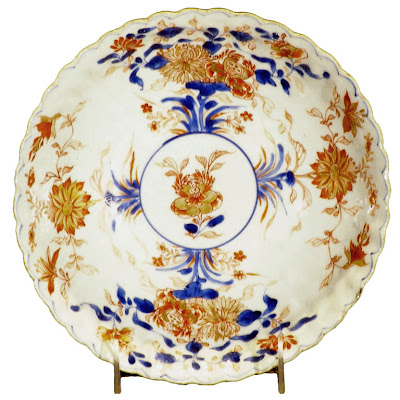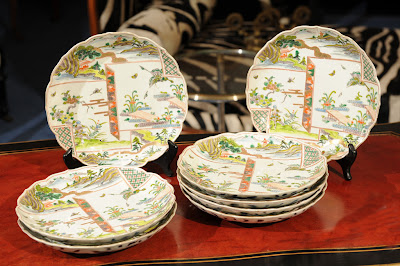I have been pondering how to express what I feel when I catch a glimpse of Imari porcelain. I could easily slip into the history, descriptions, references: blah, blah, blah. But that would not express the immense joy that I feel deep down when I experience beautiful pieces of Imari porcelain. Just a quick note: Imari Porcelain dates to the 17th c.; was/is created in Arita, Japan and exported from the port of Imari. (The Chinese adopted it and created Chinese Imari-a softer color palette-and "Tobacco Leaf". The Dutch used it as inspiration for Delft pottery. The English were inspired by Imari to create the amazing Derby--later Royal Crown Derby and Spode Imari ware). Imari also includes what is commonly referred to as Arita ware, a strictly blue and white decoration. But here I'll stick to traditional Imari patterns--true love.
The pieces that I have date to the Meiji period (1868-1912), but the truly exceptional Imari, the wonderful original abstractions date to the mid-17th to mid-18th century. Please Google Imari for more info and early examples of Imari.
I love how the deep cobalt blue of the patterns brings light, energy and joy to each piece. How the red holds my attention to focus on the intricate details of the patterns--florals, abstracts, dragons, mandalas, various shaped reserves and diapering (not the kind worn by babies) formulas. The variety of design and the creativity encompassed seems to be unique to Imari--there is a primitive artistic expression that is hidden within a refined and defined structure. And all of it calls to me. If I close my eyes I can almost imagine Jackson Pollack painting Imari plates--especially the more intricate examples shown at the end of the post--these are very busy, almost gaudy pieces (in fact, Gaudy Dutch and Gaudy Welch pottery derive from Imari, also) but are full of energy and emotion.
Just a few of the pieces that I have saved for myself:
I recently acquired this stunning pair of Imari chargers (12" diam.) that date to the Meiji Period, c. 1870-80. Yes, they are later, but the the energy of creativity is still very present. Note how the top plate was painted by an artist with a freer, more creative hand; the bottom plate is gorgeous, but just a little stiffer. Guess which one I love just a little bit more. My collector friends pooh-pooh these guys, but for my purposes they are perfection. (The early Imari price points can be atmospheric--while Meiji Imari is still within reach.) They are in my shop.
Now, a quick counterpoint to the Meiji pieces are these c. 1960-80 Japanese Imari vases fitted as a lamp (I have a pair of these beauties) in a Chinese Imari color way. Note the softness in the blue and oranges, the design is definitely a departure from traditional Imari, but still beautiful--note the traditional diaper to the rim of the vases. These are big, beefy vases (16.5" h) and note that the integrity of the porcelain has not been compromised (OH! Horrors!!) by drilling for the cord. I love the gold leafed bases--really gaudy, but great.
I acquired these two sets of Imari rice bowls quite a few years ago. And I love both of these examples, but they are quite different. The more simple bowl is earlier, probably Edo Period (c. 1840-1860), has a taller foot rim and a freer, more primitive decoration. The second example is Meiji, late 19th c.; is very refined with gilt detailing and more intricate decoration. The bowl itself is lobed and light in feel.
 |
| Late Edo Period |
 |
| Late Meiji Period |
 |
| Late Edo Period |
 |
| Late Meiji Period |
 |
| Late Edo Period |
 |
| Late Meiji Period |
Note: the "dragon" decoration to the bottom of the rice bowl of the late Meiji Period--this added detail gives another indication of the quality of the piece.
The next two dishes are much more every day dishes and I use them as under plates for my orchids--their simplicity is charming.
The next two dishes are much more every day dishes and I use them as under plates for my orchids--their simplicity is charming.
I've download a few Imari pieces from 1stdibs.com (shown below), but you can search further on Google. Every time I go "shopping" on either site, I start drooling.
 |
| English Imari |
 |
| Chinese Imari, Early 18th c. |
 |
| Green Palette Imari |
 |
| Spode Imari (English) |
(Well, I got rid of the "jump", but came up with the white highlight????--I guess, I'm convinced, that there is no such thing as perfection.)
Thanks for joining me on this hunt....Be well.
Mary, Jones and Cole
Thanks for joining me on this hunt....Be well.
Mary, Jones and Cole












I have a bowl i am trying to resesrch, i love it and just wanted to know more about it, im pretty sure its edo? But, agreed, i love this little bowl so much, its beautiful!
ReplyDelete